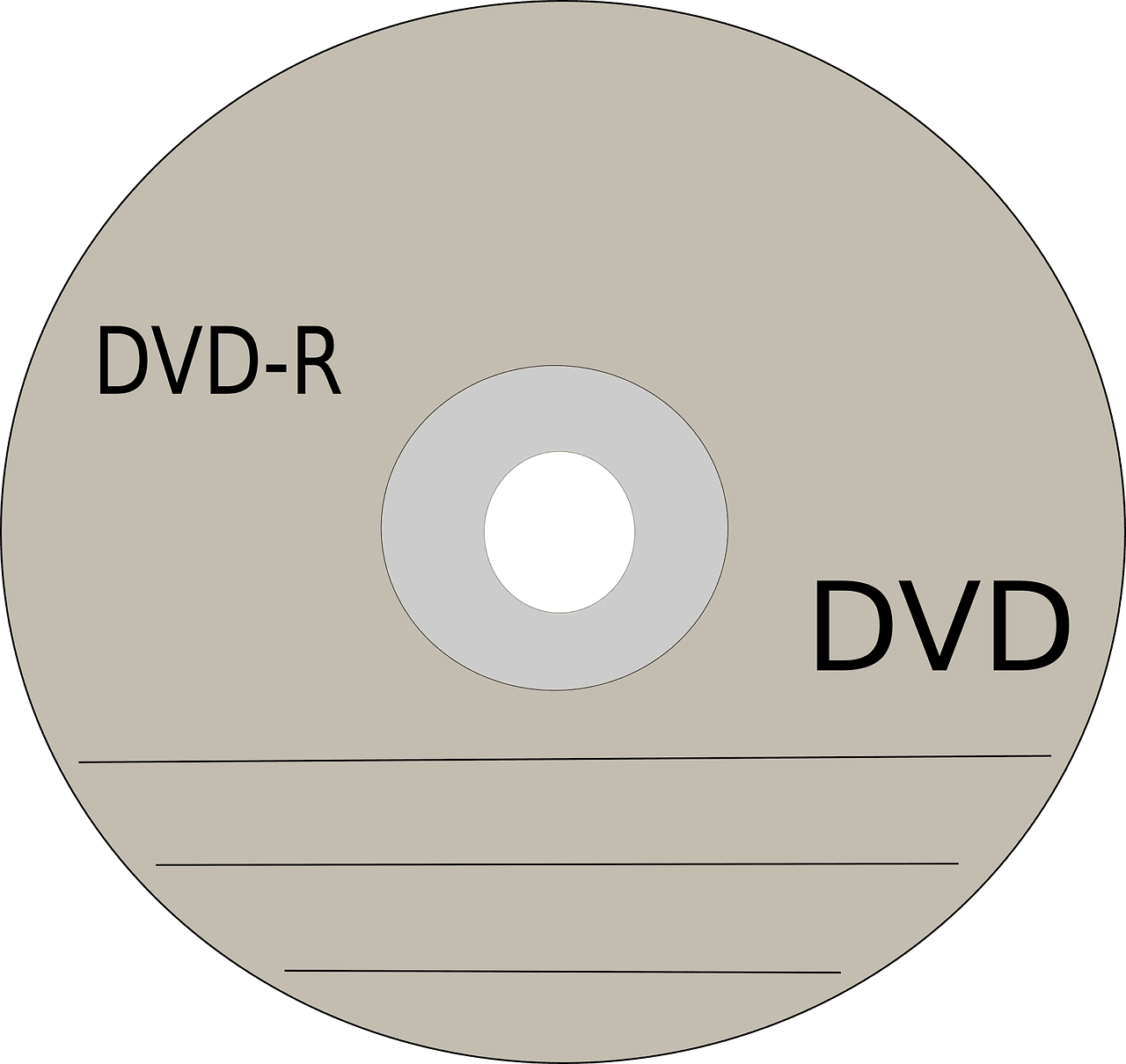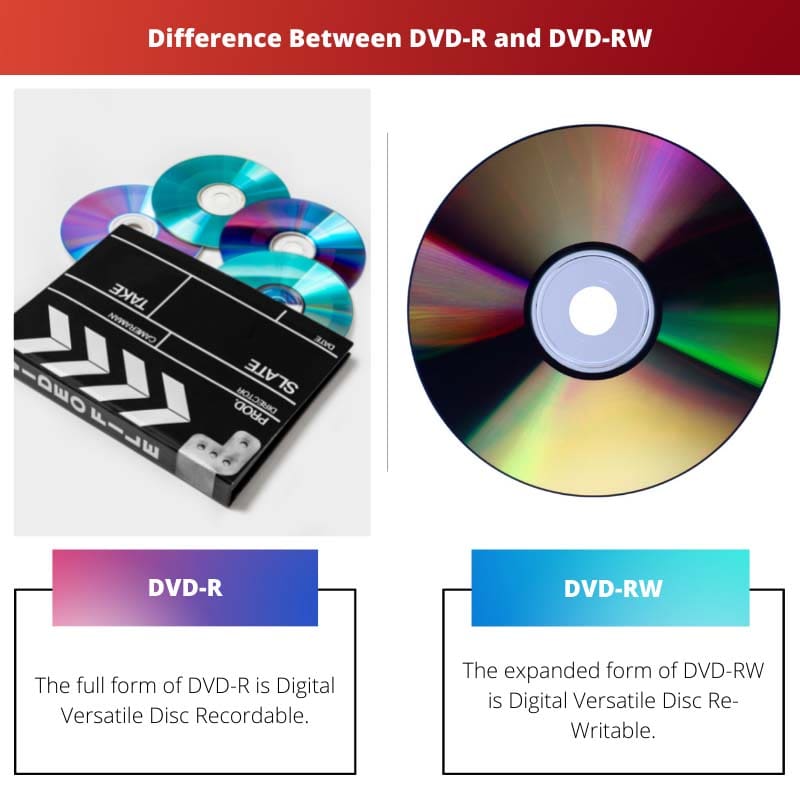There still exist cassette freaks who wish to give concrete integrity to memories or preserve essential data by saving them in cassettes, CDs, DVDs, or hard drives. This age has sensationalized the use of Android phones, pen drives, and laptops, with unlimited storage expanse. Still, the extra effort to preserve memories or essentials is absent.
So, if you are looking to store your information on DVDs while choosing to store files, you can carefully choose between DVD-R and DVD-RW discs. These discs have the same capacities, and it is easier to store the same quantity of data in either of them, no matter your choice.
However, the primary difference between DVD-R and DVD-RW is the ability to clean or erase the contents in DVD-RW.
Key Takeaways
- DVD-R (Digital Versatile Disc – Recordable) is a write-once disc format that allows users to record data or media files onto a disc. Still, it cannot be rewritten or erased once recorded.
- DVD-RW (Digital Versatile Disc – ReWritable) is a rewritable disc format that allows users to record, erase, and rewrite data or media files multiple times on the same disc.
- The key difference between DVD-R and DVD-RW formats is their reusability, with DVD-R being a one-time writable format and DVD-RW offering the capability to rewrite and erase data multiple times.
DVD-R vs. DVD-RW
DVD-R stands for Digital Versatile Disc Recordable. It is impossible to write data repeatedly in DVD-R once it has been stored. DVD-RW stands for Digital Video Disc Re-Writable. In DVD-RW, data can be erased and rewritten repeatedly. DVD-RW is versatile, which means data can be updated anytime.

Comparison Table
| Parameters of Comparison | DVD-R | DVD-RW |
|---|---|---|
| Full form | Digital Video Disc Recordable. | Digital Video Disc Re-Writable. |
| Features | Data can be written and stored only once. | Data can be erased and re-written again and again. |
| Usage | It can be used to store data. | It can store data, audio files, videos, voice messages, and images. |
| Storage | It can store a large amount of data. | It can store a lesser amount of data compared to DVD-R. |
| Speed | It is slower than DVD-RW. | Faster than DVD-R. |
What is DVD-R?
As mentioned in the introduction, the full form of DVD-R is Digital Versatile Disc Recordable. DVD-R is a circular disc of 120 mm in diameter and 1.3 mm in thickness.
The disc also contains two poly-carbonate substrates of 0.6 mm each. Almost all DVD players easily play the disc.
It is tested and approved by the DVD Forum, founded by merging various international firms.
The founder of DVD-R was Pioneer. It was founded in 1997. The disc is primarily used to store important data.
The only flaw with an otherwise efficient device is that it can be written only once. The data is incorporated with the use of a laser on it.
The disc is known to store up to 4.7 GB on single layer and single-sided discs, 8.5 GB can be stored on dual-layer discs, and 9.4 GB on double-sided discs. The storage capacity of DVD-R is greater than DVD-RW. DVD-R is cheaper than DVD-RW in price.
Also, know that both discs were released in 1997.

What is DVD-RW?
As mentioned above, the expanded form of DVD-RW is Digital Versatile Disc Re-Writable. As you can already understand by its name, it is a circular disc that is 120 mm in diameter and has a thickness of 1.3 mm.
Similar to DVD-R, DVD-RE has two poly-carbonate substrates of 0.6 mm each. The only remarkable difference separating the discs is that DVD-RW can be erased and written repeatedly, as many times as you wish.
The data is stored in the disc in digital form only.
This, too is an optical storage device. DVD-RW’s specialty is that any digital data such as audio, video messages, images or multimedia programs can be saved in it.
The disc is extensively used to install various operating systems in computers. DVD-RW has greater speed than DVD-R and is more flexible regarding storage.
Another notable feature of DVD-RW is that once uploaded in this disc, the data remains forever unless voluntarily erased by the user. Because of its efficiency and upgraded features, DVD-RW is slightly costlier than DVD-R.
However, the difference is not much. Both discs were released in 1997.

Main Differences Between DVD-R and DVD-RW
- The full form of DVD-R is Digital Video Disc Recordable. At the same time, the full form of DVD-RW is Digital Video Disc Re-Writable.
- Data in DVD-R can be written and stored only once. Whereas, in DVD-RW data can be erased and re-written again and again.
- DVD-RW can store data, audio files, videos, voice messages, and images, while DVD-R is limited to only storing valuable data.
- DVD-R can efficiently store a large amount of data, whereas DVD-RW can store less.
- DVD-R is slower than DVD-RW in speed.


While the article provides a detailed comparison between DVD-R and DVD-RW, the narrative captures the essence and evolution of disc technology, making it an interesting read for tech enthusiasts.
Absolutely, the historical perspective combined with technical details creates an engaging narrative. One can appreciate the significance of these disc formats from both a historical and functional standpoint.
The discussion on the advantages and limitations of DVD-R and DVD-RW, along with the release history, provides a well-rounded understanding of these disc technologies.
The detail about the history, features, and capacities of both DVD-R and DVD-RW discs is impressive. It helps people understand the evolution of disc technology and how it applies to their needs.
Indeed, this article offers a comprehensive look into the functionality, benefits, and limitations of DVD-R and DVD-RW. It’s a great resource for anyone looking to understand these disc formats.
The analysis of DVD-R and DVD-RW along with their features and release histories is insightful and serves to educate readers on the complexities and implications of disc storage technology.
Indeed, this article provides a well-researched and comprehensive view of DVD-R and DVD-RW, catering to the intellectual curiosity of readers seeking insightful information.
The historical background, features, and functional comparison between DVD-R and DVD-RW add depth and clarity to the article, making it a valuable resource for readers interested in disc storage.
The article’s comprehensive approach to detailing DVD-R and DVD-RW imparts significant knowledge to readers, providing a holistic understanding of these disc technologies.
Absolutely, the detailed analysis and nuanced evaluation of DVD-R and DVD-RW offers readers a thorough understanding of these disc formats and their applications.
The article is informative in detailing the differences between DVD-R and DVD-RW, along with their features, capacities, and pricing. It provides a comprehensive overview of these disc types.
I agree, the detailed comparison and historical background make the article very insightful and educational, especially for those interested in storage technologies.
The thorough analysis of DVD-R and DVD-RW, including their functionalities and release dates, helps readers grasp the significance and implications of these disc formats in contemporary technology.
The article delivers a thorough examination of the features, functionalities, and distinctions between DVD-R and DVD-RW, fostering a profound understanding of these disc technologies among readers.
Indeed, the article offers an enlightening perspective on DVD-R and DVD-RW, enabling readers to grasp the complexities and implications of these disc formats with precision.
The detailed insights and analytical approach to explaining DVD-R and DVD-RW enrich the understanding of readers, providing a holistic view of these disc formats and their utilitarian value.
This article offers a comprehensive look into the functionalities and applications of DVD-R and DVD-RW, providing a nuanced understanding of the two disc formats and their respective benefits.
The article effectively captures the technical nuances and practical applications of both DVD-R and DVD-RW, contributing to a deeper understanding of these disc formats.
I completely agree. The in-depth analysis and detailed comparison of DVD-R and DVD-RW adds substantial value for readers aiming to make informed decisions regarding disc storage.
The article explains the technical differences between DVD-R and DVD-RW in an enriching and informative manner, helping readers understand the distinctions and applications of these disc formats.
Absolutely, the detailed comparison, features, and applications of both DVD-R and DVD-RW provide valuable insights for individuals looking to utilize these disc formats effectively.
The information about DVD-R and DVD-RW discs is very useful and thorough. It also provides key takeaways and a comparison table, making it easier to understand and make a decision on which disc to use.
I completely agree with you. This article is very informative and helpful in understanding the differences between these disc formats and making an informed choice.
The article effectively captures the essence and technical distinctions between DVD-R and DVD-RW, catering to the intellectual curiosity of tech enthusiasts and readers intrigued by storage technologies.
The historical context, features, and practical applications discussed in the article accentuate the informative value of understanding DVD-R and DVD-RW, offering a robust foundation of insight.
I concur. The detailed explanation and comparison of DVD-R and DVD-RW elevate the article’s merit, assisting readers in comprehending the intricacies of these disc formats.